I'll post them somewhere, especially if I have time to try them in application and perhaps even try to record any differences if there is. Not sure yet how to do it. Currently I have only one waveguide, RCF H100, that has mounting points for all the drivers. There is plenty all kinds of evaluations of drivers on the web so I'm not sure how to contribute. The test is for me mainly, to be able to listen. Tests from others are just text 🙂Aha - that fleece is actually felt and it is set around like a scarf - it was initially to fill the void between the WG and the concrete housing but it happened to double as diffraction catcher... now still do fill duty but diffraction job is now the duty of Chewbacka... 😉
I'll will later post the print file for the fins I made for the 260 so you could try them.
OK - very interesting that you will try with different driver - please come back and tell me your findings!?
//
Personally I think there is not going to be too much of a difference when put into application and EQ:d reasonably the same, which is also main motivation why I wanted to try them. I'm not sure what to expect, how meaningful any audible differences are, or how to document it and so on 🙂 It is excersize that hopefully helps to learn listen sound quality what might be due to waveguide or due to driver. Optimally,any of those would have their own waveguides, throats optimized for each, equalized for application and very close to each other, certainly within 0.5db.
Last edited:
Well the contribution would be to have a comparison using one of, if not the (?), best WGs on the market? 🙂 but I see that mounting is a problem...
I'm planning to do fins / no fins comparison measurements... IMD is interesting... need to see if I can perform that. Finger method?
//
I'm planning to do fins / no fins comparison measurements... IMD is interesting... need to see if I can perform that. Finger method?
//
Yeah, except no matter how I describe it nobody else hears the actual difference so not sure how relevant it would be to anyone else but me listening to them?
Well, just speculation before actually doing it. I do not know yet what the difference actually is, and then I need to evaluate if I could or could not capture the differences so that it would be relevant to others without actually being there with me doing the tests 🙂 There is likely difference in measurements and difference to my hearing, but not sure if that is relevant to others in their context, or how to present the difference over internet so that it is somehow possible to relate the results to what ever context everyone has.
Example, if I cannot hear a difference it doesn't mean you wouldn't, magnitude for you could be different than for me. Also, I could think something sounds worse which you might find out sounds better to you based on our different backgrounds on listening stuff, and so on 🙂
Well, just speculation before actually doing it. I do not know yet what the difference actually is, and then I need to evaluate if I could or could not capture the differences so that it would be relevant to others without actually being there with me doing the tests 🙂 There is likely difference in measurements and difference to my hearing, but not sure if that is relevant to others in their context, or how to present the difference over internet so that it is somehow possible to relate the results to what ever context everyone has.
Example, if I cannot hear a difference it doesn't mean you wouldn't, magnitude for you could be different than for me. Also, I could think something sounds worse which you might find out sounds better to you based on our different backgrounds on listening stuff, and so on 🙂
Last edited:
Hi, I was silly and forgot to take multitone measurement before modifying both waveguides! took some on axis mesurements though, but any differences seem to fall within error margin. I was in a haste though, and excited that a layer of viscoelastic glue behind waveguide rim seemed to make quite a difference. Adding more and more, tapping with finger and listening the ringing, gradually making it less noisy sounding. Listened stereo only one waveguide treated and phantom center seemed awkward so it must have made some difference, although there is still some improvement with the finger technique and it was late night and so on. In other words there seems to be a difference. Should have recorded the tapping as well 😀
Perhaps not too surprisingly, I think most difference happened on sound behind the waveguide, but don't have measurement on that either and listening situation wasn't an a/b test but notion afterwards. And, finger technique gives bigger difference behind the waveguide, even though there is the glue treatment.
Well, be it real difference or not it has taken me listening stuff, and thinking about listening and it's role on all of this hobby. It's the most important thing, obviously, and building speakers is a great way to practice listening skills for any person that needs listening with their job or hobby. Developing listening skills helps the diy speaker end up better as well, must help.
I've just recently understood how to actually listen so that usefull information can be reasoned with the perception. Key thing is to vary the thing you try to listen to. Like, move your position, or use a finger technique on resonance, do something you can control the change with. Toe in a speaker playing music and listen how the early reflections change. Move it live, wave your hand in front of you, and so on. Listening between two perspectives on something allows to compare them and reason about what is it that you are listening. Record with mic, listen with headphones, what ever you come up with trying to hear something you aren't sure about, yet.
More over, now thinking about it, what seems to be important, or somehow a common "bad" in this kind of small listening experiments I've been doing; the worse perspective very often seems to sound noisy, noisy compared to the other seemingly better sounding perspective on it. Reasoning, the noise, or what makes a noisy sound in each occasion, is the most audible "issue" 🙂 which is convenient as many concepts can be thought as noise. For example harmonic distortion is noise, must be, if it was "like music" then it would sound like music, nice, but instead could be noisy sounding if loud enough on certain harmonics or something, it would sound not like the music but noise on it and poke through. Tune time alignment live with DSP and listen things clearing up, kind of like noise was reduced, image cleared up a bit. Listening behind loudspeaker, ear quite close to it to hear smaller local sounds in context, there is position that doesn't seem to sound right but bit noisy, there is likely some diffraction peak or panel resonance, perhaps accompanied with reflection of close boundary or something, it just pokes through to ear what ever it is. Room mode peak or an old freezer in the kitchen.
Well, it's all kinda speculative, but since differences in this kind of listening tests seem to be audible, something wrong is loud enough to be detected, something not like the music, that would be the offender for good sound quality, right? what ever that is. So, first suspect sound quality issue is anything that sounds like noise. What one should do is to learn to listen about what it is, how to test and verify what's causing it and try to reduce for more clarity, less noise.
Well, just having fun with the hobby, thinkin about stuff, and listening music 😀 what do you think, how you listen things? 🙂
Perhaps not too surprisingly, I think most difference happened on sound behind the waveguide, but don't have measurement on that either and listening situation wasn't an a/b test but notion afterwards. And, finger technique gives bigger difference behind the waveguide, even though there is the glue treatment.
Well, be it real difference or not it has taken me listening stuff, and thinking about listening and it's role on all of this hobby. It's the most important thing, obviously, and building speakers is a great way to practice listening skills for any person that needs listening with their job or hobby. Developing listening skills helps the diy speaker end up better as well, must help.
I've just recently understood how to actually listen so that usefull information can be reasoned with the perception. Key thing is to vary the thing you try to listen to. Like, move your position, or use a finger technique on resonance, do something you can control the change with. Toe in a speaker playing music and listen how the early reflections change. Move it live, wave your hand in front of you, and so on. Listening between two perspectives on something allows to compare them and reason about what is it that you are listening. Record with mic, listen with headphones, what ever you come up with trying to hear something you aren't sure about, yet.
More over, now thinking about it, what seems to be important, or somehow a common "bad" in this kind of small listening experiments I've been doing; the worse perspective very often seems to sound noisy, noisy compared to the other seemingly better sounding perspective on it. Reasoning, the noise, or what makes a noisy sound in each occasion, is the most audible "issue" 🙂 which is convenient as many concepts can be thought as noise. For example harmonic distortion is noise, must be, if it was "like music" then it would sound like music, nice, but instead could be noisy sounding if loud enough on certain harmonics or something, it would sound not like the music but noise on it and poke through. Tune time alignment live with DSP and listen things clearing up, kind of like noise was reduced, image cleared up a bit. Listening behind loudspeaker, ear quite close to it to hear smaller local sounds in context, there is position that doesn't seem to sound right but bit noisy, there is likely some diffraction peak or panel resonance, perhaps accompanied with reflection of close boundary or something, it just pokes through to ear what ever it is. Room mode peak or an old freezer in the kitchen.
Well, it's all kinda speculative, but since differences in this kind of listening tests seem to be audible, something wrong is loud enough to be detected, something not like the music, that would be the offender for good sound quality, right? what ever that is. So, first suspect sound quality issue is anything that sounds like noise. What one should do is to learn to listen about what it is, how to test and verify what's causing it and try to reduce for more clarity, less noise.
Well, just having fun with the hobby, thinkin about stuff, and listening music 😀 what do you think, how you listen things? 🙂
Last edited:
I haven't been able to buy one yet. But pile of prototype plans seem to grow so it perhaps makes sense to consider investing in one 🙂 unfortunately, I haven' been able to find any affordable local service to have prototypes made, luckily there seems to be plenty available online.
Last edited:
https://3d.jlcpcb.com/3d-printing-quote?from=homepage
Just add the file I posted above - wait 20 days... or shorter but then shipping is expensive...

//
Just add the file I posted above - wait 20 days... or shorter but then shipping is expensive...
//
TNT,
I ain't ordering now... tryin' to be helpful by providing another option for 3D printing...
I ain't ordering now... tryin' to be helpful by providing another option for 3D printing...
Since started posting about this stuff here I'll continue to keep everything in same place, if you don't mind TNT?🙂 Had some time today to make multitone test.Hi, I was silly and forgot to take multitone measurement before modifying both waveguides! took some on axis mesurements though, but any differences seem to fall within error margin. I was in a haste though, and excited that a layer of viscoelastic glue behind waveguide rim seemed to make quite a difference. Adding more and more, tapping with finger and listening the ringing, gradually making it less noisy sounding. Listened stereo only one waveguide treated and phantom center seemed awkward so it must have made some difference, although there is still some improvement with the finger technique and it was late night and so on. In other words there seems to be a difference. Should have recorded the tapping as well 😀
Perhaps not too surprisingly, I think most difference happened on sound behind the waveguide, but don't have measurement on that either and listening situation wasn't an a/b test but notion afterwards. And, finger technique gives bigger difference behind the waveguide, even though there is the glue treatment.
Well, be it real difference or not it has taken me listening stuff, and thinking about listening and it's role on all of this hobby. It's the most important thing, obviously, and building speakers is a great way to practice listening skills for any person that needs listening with their job or hobby. Developing listening skills helps the diy speaker end up better as well, must help.
I've just recently understood how to actually listen so that usefull information can be reasoned with the perception. Key thing is to vary the thing you try to listen to. Like, move your position, or use a finger technique on resonance, do something you can control the change with. Toe in a speaker playing music and listen how the early reflections change. Move it live, wave your hand in front of you, and so on. Listening between two perspectives on something allows to compare them and reason about what is it that you are listening. Record with mic, listen with headphones, what ever you come up with trying to hear something you aren't sure about, yet.
More over, now thinking about it, what seems to be important, or somehow a common "bad" in this kind of small listening experiments I've been doing; the worse perspective very often seems to sound noisy, noisy compared to the other seemingly better sounding perspective on it. Reasoning, the noise, or what makes a noisy sound in each occasion, is the most audible "issue" 🙂 which is convenient as many concepts can be thought as noise. For example harmonic distortion is noise, must be, if it was "like music" then it would sound like music, nice, but instead could be noisy sounding if loud enough on certain harmonics or something, it would sound not like the music but noise on it and poke through. Tune time alignment live with DSP and listen things clearing up, kind of like noise was reduced, image cleared up a bit. Listening behind loudspeaker, ear quite close to it to hear smaller local sounds in context, there is position that doesn't seem to sound right but bit noisy, there is likely some diffraction peak or panel resonance, perhaps accompanied with reflection of close boundary or something, it just pokes through to ear what ever it is. Room mode peak or an old freezer in the kitchen.
Well, it's all kinda speculative, but since differences in this kind of listening tests seem to be audible, something wrong is loud enough to be detected, something not like the music, that would be the offender for good sound quality, right? what ever that is. So, first suspect sound quality issue is anything that sounds like noise. What one should do is to learn to listen about what it is, how to test and verify what's causing it and try to reduce for more clarity, less noise.
Well, just having fun with the hobby, thinkin about stuff, and listening music 😀 what do you think, how you listen things? 🙂
Finger technique doesn't seem to show meaningful difference in multitone test, but now I have the treated waveguides only, perhaps it would have shown earlier.
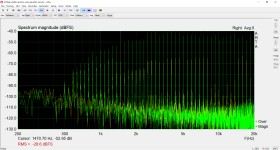
Found out that knocking the speaker structure from behind close to compression driver the waveguide ringing was audible, no music playing. Recorded the knocking with mic and sure enough the resonances seem to be quite low in frequency, below pass band. Here "spectral analysis" of the recording, first image showing the ringing, second image is damping the waveguide with hand. Most difference seems to be somewhere around 200Hz and below 1kHz.
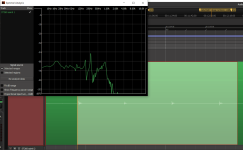
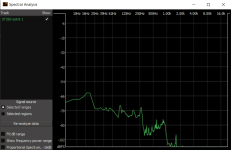
Zoomed waveforms, first knock is with finger damping and second is not. Listen mp3 file, first four knocks are with finger damping and last four without, ringing readily audible.
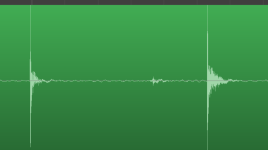
Since the resonances are is so low in frequency played the whole speaker. Here multitone measurement with mic perhaps 50cm away trying to capture any difference, but it's about in the error margin.
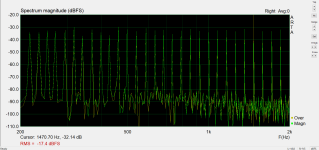
The ringing is easily audible while knocking the waveguide, but hardly audible anymore with music playing and using the finger technique.
Anyway, the multitone signal was quite ruthless showing cabinet resonances for touch, much more so than music. With music it's hard to tell if hand feels a vibration for some reason, but with the multitone playing it's very evident the structure resonates. Not sure what to think about it but anyway, if there is need to analyze cabinet vibrations try multitone signal.
Last edited:
Hi!
What was the DUT? Just the WG or whole speaker? Multitone was from 200Hz - was this only WG?
In the mp3 the bigger peak (5th) in the middle of the recording sound really nasty - it has that resonance ring to it - awful!
Need to try some multi-tones....
I think it is important to see to that noting else than the membranes in a speaker moves. I'll go long to achieve that. I'm nor sure I succeeded fully in the Horflowers - probably more to be done. But I''m contemplating a bigger model 🙂
60cm dia WG and 6 pcs of 5" bases per speaker....

//
What was the DUT? Just the WG or whole speaker? Multitone was from 200Hz - was this only WG?
In the mp3 the bigger peak (5th) in the middle of the recording sound really nasty - it has that resonance ring to it - awful!
Need to try some multi-tones....
I think it is important to see to that noting else than the membranes in a speaker moves. I'll go long to achieve that. I'm nor sure I succeeded fully in the Horflowers - probably more to be done. But I''m contemplating a bigger model 🙂
60cm dia WG and 6 pcs of 5" bases per speaker....
//
The whole speaker silent, just me knocking back of the thing, and resonance transmitting to the waveguide which then rings. Mic was perhaps 10cm in front of the waveguide. Four first knocks is damped with my other hand, last fpur knocks without damping and it rings 🙂
Luckily, knocking around mid driver or woofer portion of the system, and the waveguide doesn't make a sound, but only if I knock behind the CD the resonances transmit and make it sing.
Luckily, knocking around mid driver or woofer portion of the system, and the waveguide doesn't make a sound, but only if I knock behind the CD the resonances transmit and make it sing.
I not sure I still can follow... Can you post a picture of the speaker? Do you mena that you knock on the Compression Driver backside?
Perhaps we shouldn't make this thread to a general "cabinet resonances" discussion after all. I'm really into the subject and very interested. Perhaps you could open a thread about this where ideas and tests could be shared?
//
Perhaps we shouldn't make this thread to a general "cabinet resonances" discussion after all. I'm really into the subject and very interested. Perhaps you could open a thread about this where ideas and tests could be shared?
//
I started thread about listening stuff, referred to posts in this thread and asked to continue there if anyone want's to comment on it 🙂 I'll continue there.
https://www.diyaudio.com/community/threads/listening-about-things.402922/post-7443536
https://www.diyaudio.com/community/threads/listening-about-things.402922/post-7443536
Hi TNT,
Kindest regards,
M
I have a different wave-guide, so I will have to print my own, but I was wondering if you investigated how long (axially) the fins have to be to have any (measurable) effect.Try a pair of fins for your WG . . .
Kindest regards,
M
- Home
- Loudspeakers
- Multi-Way
- Hornflower 2-way point source